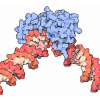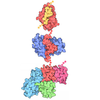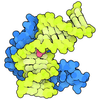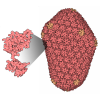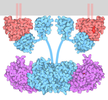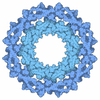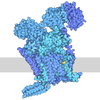+ Open data
Open data
- Basic information
Basic information
| Entry | Database: PDB / ID: 6tbm | ||||||||||||
|---|---|---|---|---|---|---|---|---|---|---|---|---|---|
| Title | Structure of SAGA bound to TBP, including Spt8 and DUB | ||||||||||||
 Components Components |
| ||||||||||||
 Keywords Keywords | TRANSCRIPTION / Transcriptional co-activator / Histone-acetylation | ||||||||||||
| Function / homology |  Function and homology information Function and homology informationregulation of biosynthetic process / SAGA-type complex / RITS complex assembly / DUBm complex / positive regulation of DNA-templated transcription initiation / TFIIA-class transcription factor complex binding / RNA polymerase III transcription regulatory region sequence-specific DNA binding / RNA polymerase III preinitiation complex assembly / regulatory ncRNA-mediated heterochromatin formation / transcription export complex 2 ...regulation of biosynthetic process / SAGA-type complex / RITS complex assembly / DUBm complex / positive regulation of DNA-templated transcription initiation / TFIIA-class transcription factor complex binding / RNA polymerase III transcription regulatory region sequence-specific DNA binding / RNA polymerase III preinitiation complex assembly / regulatory ncRNA-mediated heterochromatin formation / transcription export complex 2 / transcription factor TFIIIB complex / RNA polymerase I general transcription initiation factor binding / nuclear mRNA surveillance / SLIK (SAGA-like) complex / post-transcriptional tethering of RNA polymerase II gene DNA at nuclear periphery / regulation of transcription by RNA polymerase III / transcription factor TFIIA complex / RNA polymerase I preinitiation complex assembly / hypothalamus gonadotrophin-releasing hormone neuron development / SAGA complex / female meiosis I / positive regulation of protein monoubiquitination / DNA binding, bending / fat pad development / mitochondrion transport along microtubule / RNA Polymerase III Transcription Initiation From Type 2 Promoter / RNA polymerase II transcribes snRNA genes / poly(A)+ mRNA export from nucleus / RNA Polymerase II Promoter Escape / RNA Polymerase II Transcription Pre-Initiation And Promoter Opening / RNA Polymerase II Transcription Initiation / RNA Polymerase II Transcription Initiation And Promoter Clearance / RNA polymerase II general transcription initiation factor activity / transcription factor TFIID complex / RNA Polymerase II Pre-transcription Events / female gonad development / seminiferous tubule development / RNA Polymerase I Promoter Escape / NuA4 histone acetyltransferase complex / male meiosis I / nucleolar large rRNA transcription by RNA polymerase I / Estrogen-dependent gene expression / positive regulation of intrinsic apoptotic signaling pathway by p53 class mediator / protein deubiquitination / nuclear pore / RNA polymerase II core promoter sequence-specific DNA binding / RNA polymerase II preinitiation complex assembly / energy homeostasis / regulation of neuron apoptotic process / neuron projection morphogenesis / regulation of proteasomal protein catabolic process / Maturation of protein E / Maturation of protein E / ER Quality Control Compartment (ERQC) / Myoclonic epilepsy of Lafora / FLT3 signaling by CBL mutants / Prevention of phagosomal-lysosomal fusion / IRAK2 mediated activation of TAK1 complex / Alpha-protein kinase 1 signaling pathway / Glycogen synthesis / IRAK1 recruits IKK complex / IRAK1 recruits IKK complex upon TLR7/8 or 9 stimulation / Endosomal Sorting Complex Required For Transport (ESCRT) / Membrane binding and targetting of GAG proteins / Negative regulation of FLT3 / Regulation of TBK1, IKKε (IKBKE)-mediated activation of IRF3, IRF7 / PTK6 Regulates RTKs and Their Effectors AKT1 and DOK1 / Regulation of TBK1, IKKε-mediated activation of IRF3, IRF7 upon TLR3 ligation / Constitutive Signaling by NOTCH1 HD Domain Mutants / IRAK2 mediated activation of TAK1 complex upon TLR7/8 or 9 stimulation / NOTCH2 Activation and Transmission of Signal to the Nucleus / TICAM1,TRAF6-dependent induction of TAK1 complex / TICAM1-dependent activation of IRF3/IRF7 / APC/C:Cdc20 mediated degradation of Cyclin B / Downregulation of ERBB4 signaling / Regulation of FZD by ubiquitination / APC-Cdc20 mediated degradation of Nek2A / p75NTR recruits signalling complexes / InlA-mediated entry of Listeria monocytogenes into host cells / TRAF6 mediated IRF7 activation in TLR7/8 or 9 signaling / TRAF6-mediated induction of TAK1 complex within TLR4 complex / Regulation of pyruvate metabolism / NF-kB is activated and signals survival / Regulation of innate immune responses to cytosolic DNA / Downregulation of ERBB2:ERBB3 signaling / Pexophagy / NRIF signals cell death from the nucleus / VLDLR internalisation and degradation / Regulation of PTEN localization / TBP-class protein binding / Activated NOTCH1 Transmits Signal to the Nucleus / Regulation of BACH1 activity / Synthesis of active ubiquitin: roles of E1 and E2 enzymes / MAP3K8 (TPL2)-dependent MAPK1/3 activation / TICAM1, RIP1-mediated IKK complex recruitment / Translesion synthesis by REV1 / InlB-mediated entry of Listeria monocytogenes into host cell / Translesion synthesis by POLK / Activation of IRF3, IRF7 mediated by TBK1, IKKε (IKBKE) / Downregulation of TGF-beta receptor signaling Similarity search - Function | ||||||||||||
| Biological species |  Komagataella phaffii (fungus) Komagataella phaffii (fungus) Homo sapiens (human) Homo sapiens (human) Komagataella phaffii GS115 (fungus) Komagataella phaffii GS115 (fungus) | ||||||||||||
| Method | ELECTRON MICROSCOPY / single particle reconstruction / cryo EM / Resolution: 20 Å | ||||||||||||
 Authors Authors | Papai, G. / Frechard, A. / Kolesnikova, O. / Crucifix, C. / Schultz, P. / Ben-Shem, A. | ||||||||||||
| Funding support |  France, 3items France, 3items
| ||||||||||||
 Citation Citation |  Journal: Nature / Year: 2020 Journal: Nature / Year: 2020Title: Structure of SAGA and mechanism of TBP deposition on gene promoters. Authors: Gabor Papai / Alexandre Frechard / Olga Kolesnikova / Corinne Crucifix / Patrick Schultz / Adam Ben-Shem /  Abstract: SAGA (Spt-Ada-Gcn5-acetyltransferase) is a 19-subunit complex that stimulates transcription via two chromatin-modifying enzymatic modules and by delivering the TATA box binding protein (TBP) to ...SAGA (Spt-Ada-Gcn5-acetyltransferase) is a 19-subunit complex that stimulates transcription via two chromatin-modifying enzymatic modules and by delivering the TATA box binding protein (TBP) to nucleate the pre-initiation complex on DNA, a pivotal event in the expression of protein-encoding genes. Here we present the structure of yeast SAGA with bound TBP. The core of the complex is resolved at 3.5 Å resolution (0.143 Fourier shell correlation). The structure reveals the intricate network of interactions that coordinate the different functional domains of SAGA and resolves an octamer of histone-fold domains at the core of SAGA. This deformed octamer deviates considerably from the symmetrical analogue in the nucleosome and is precisely tuned to establish a peripheral site for TBP, where steric hindrance represses binding of spurious DNA. Complementary biochemical analysis points to a mechanism for TBP delivery and release from SAGA that requires transcription factor IIA and whose efficiency correlates with the affinity of DNA to TBP. We provide the foundations for understanding the specific delivery of TBP to gene promoters and the multiple roles of SAGA in regulating gene expression. | ||||||||||||
| History |
|
- Structure visualization
Structure visualization
| Movie |
 Movie viewer Movie viewer |
|---|---|
| Structure viewer | Molecule:  Molmil Molmil Jmol/JSmol Jmol/JSmol |
- Downloads & links
Downloads & links
- Download
Download
| PDBx/mmCIF format |  6tbm.cif.gz 6tbm.cif.gz | 1.2 MB | Display |  PDBx/mmCIF format PDBx/mmCIF format |
|---|---|---|---|---|
| PDB format |  pdb6tbm.ent.gz pdb6tbm.ent.gz | 921.7 KB | Display |  PDB format PDB format |
| PDBx/mmJSON format |  6tbm.json.gz 6tbm.json.gz | Tree view |  PDBx/mmJSON format PDBx/mmJSON format | |
| Others |  Other downloads Other downloads |
-Validation report
| Summary document |  6tbm_validation.pdf.gz 6tbm_validation.pdf.gz | 963.7 KB | Display |  wwPDB validaton report wwPDB validaton report |
|---|---|---|---|---|
| Full document |  6tbm_full_validation.pdf.gz 6tbm_full_validation.pdf.gz | 1.1 MB | Display | |
| Data in XML |  6tbm_validation.xml.gz 6tbm_validation.xml.gz | 162.2 KB | Display | |
| Data in CIF |  6tbm_validation.cif.gz 6tbm_validation.cif.gz | 257.7 KB | Display | |
| Arichive directory |  https://data.pdbj.org/pub/pdb/validation_reports/tb/6tbm https://data.pdbj.org/pub/pdb/validation_reports/tb/6tbm ftp://data.pdbj.org/pub/pdb/validation_reports/tb/6tbm ftp://data.pdbj.org/pub/pdb/validation_reports/tb/6tbm | HTTPS FTP |
-Related structure data
| Related structure data |  10446MC  6tb4C C: citing same article ( M: map data used to model this data |
|---|---|
| Similar structure data |
- Links
Links
- Assembly
Assembly
| Deposited unit | 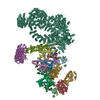
|
|---|---|
| 1 |
|
- Components
Components
-Protein , 12 types, 12 molecules MCFKGHILNRQO
| #1: Protein | Mass: 27042.275 Da / Num. of mol.: 1 Source method: isolated from a genetically manipulated source Source: (gene. exp.)  Komagataella phaffii (strain GS115 / ATCC 20864) (fungus) Komagataella phaffii (strain GS115 / ATCC 20864) (fungus)Gene: SPT15 / Production host:  |
|---|---|
| #3: Protein | Mass: 79995.227 Da / Num. of mol.: 1 Source method: isolated from a genetically manipulated source Source: (gene. exp.)  Komagataella phaffii (strain GS115 / ATCC 20864) (fungus) Komagataella phaffii (strain GS115 / ATCC 20864) (fungus)Strain: GS115 / ATCC 20864 / Gene: PAS_chr1-4_0651 / Production host:  |
| #4: Protein | Mass: 59530.578 Da / Num. of mol.: 1 / Source method: isolated from a natural source Source: (natural)  Komagataella phaffii (strain GS115 / ATCC 20864) (fungus) Komagataella phaffii (strain GS115 / ATCC 20864) (fungus)Strain: GS115 / ATCC 20864 / References: UniProt: C4QZ05 |
| #8: Protein | Mass: 66690.133 Da / Num. of mol.: 1 / Source method: isolated from a natural source Source: (natural)  Komagataella phaffii (strain GS115 / ATCC 20864) (fungus) Komagataella phaffii (strain GS115 / ATCC 20864) (fungus)Strain: GS115 / ATCC 20864 / References: UniProt: C4R150 |
| #9: Protein | Mass: 80933.008 Da / Num. of mol.: 1 / Source method: isolated from a natural source Source: (natural)  Komagataella phaffii (strain GS115 / ATCC 20864) (fungus) Komagataella phaffii (strain GS115 / ATCC 20864) (fungus)Strain: GS115 / ATCC 20864 / References: UniProt: C4R4L4 |
| #10: Protein | Mass: 54888.445 Da / Num. of mol.: 1 / Source method: isolated from a natural source Source: (natural)  Komagataella phaffii (strain GS115 / ATCC 20864) (fungus) Komagataella phaffii (strain GS115 / ATCC 20864) (fungus)Strain: GS115 / ATCC 20864 / References: UniProt: C4QW33 |
| #11: Protein | Mass: 17303.576 Da / Num. of mol.: 1 / Source method: isolated from a natural source Source: (natural)  Komagataella phaffii (strain GS115 / ATCC 20864) (fungus) Komagataella phaffii (strain GS115 / ATCC 20864) (fungus)Strain: GS115 / ATCC 20864 / References: UniProt: C4QZS5 |
| #12: Protein | Mass: 438055.344 Da / Num. of mol.: 1 / Source method: isolated from a natural source Source: (natural)  Komagataella phaffii (strain GS115 / ATCC 20864) (fungus) Komagataella phaffii (strain GS115 / ATCC 20864) (fungus)Strain: GS115 / ATCC 20864 / References: UniProt: C4QYV4 |
| #14: Protein | Mass: 34059.902 Da / Num. of mol.: 1 / Source method: isolated from a natural source / Source: (natural)  Komagataella phaffii GS115 (fungus) / Strain: GS115 / ATCC 20864 Komagataella phaffii GS115 (fungus) / Strain: GS115 / ATCC 20864 |
| #15: Protein | Mass: 8560.831 Da / Num. of mol.: 1 Source method: isolated from a genetically manipulated source Source: (gene. exp.)  Homo sapiens (human) / Gene: UBB / Production host: Homo sapiens (human) / Gene: UBB / Production host:  |
| #16: Protein | Mass: 56745.879 Da / Num. of mol.: 1 / Source method: isolated from a natural source Source: (natural)  Komagataella phaffii (strain GS115 / ATCC 20864) (fungus) Komagataella phaffii (strain GS115 / ATCC 20864) (fungus)Strain: GS115 / ATCC 20864 / References: UniProt: C4QY61, ubiquitinyl hydrolase 1 |
| #17: Protein | Mass: 13977.742 Da / Num. of mol.: 1 / Source method: isolated from a natural source Source: (natural)  Komagataella phaffii (strain GS115 / ATCC 20864) (fungus) Komagataella phaffii (strain GS115 / ATCC 20864) (fungus)Strain: GS115 / ATCC 20864 / References: UniProt: C4R2D9 |
-Transcriptional ... , 2 types, 2 molecules AB
| #2: Protein | Mass: 49888.273 Da / Num. of mol.: 1 / Source method: isolated from a natural source Source: (natural)  Komagataella phaffii (strain GS115 / ATCC 20864) (fungus) Komagataella phaffii (strain GS115 / ATCC 20864) (fungus)Strain: GS115 / ATCC 20864 / References: UniProt: C4QZA3 |
|---|---|
| #13: Protein | Mass: 81864.305 Da / Num. of mol.: 1 / Source method: isolated from a natural source Source: (natural)  Komagataella phaffii (strain GS115 / ATCC 20864) (fungus) Komagataella phaffii (strain GS115 / ATCC 20864) (fungus)Strain: GS115 / ATCC 20864 / References: UniProt: C4R2A4 |
-Subunit of the SAGA ... , 2 types, 2 molecules DE
| #5: Protein | Mass: 39030.105 Da / Num. of mol.: 1 / Source method: isolated from a natural source Source: (natural)  Komagataella phaffii (strain GS115 / ATCC 20864) (fungus) Komagataella phaffii (strain GS115 / ATCC 20864) (fungus)Strain: GS115 / ATCC 20864 / References: UniProt: C4R3E4 |
|---|---|
| #6: Protein | Mass: 136768.828 Da / Num. of mol.: 1 / Source method: isolated from a natural source Source: (natural)  Komagataella phaffii (strain GS115 / ATCC 20864) (fungus) Komagataella phaffii (strain GS115 / ATCC 20864) (fungus)Strain: GS115 / ATCC 20864 / References: UniProt: C4R5C7 |
-Transcription ... , 2 types, 2 molecules JP
| #7: Protein | Mass: 23879.145 Da / Num. of mol.: 1 / Source method: isolated from a natural source Source: (natural)  Komagataella phaffii (strain GS115 / ATCC 20864) (fungus) Komagataella phaffii (strain GS115 / ATCC 20864) (fungus)Strain: GS115 / ATCC 20864 / References: UniProt: C4QXP2 |
|---|---|
| #18: Protein | Mass: 11126.675 Da / Num. of mol.: 1 / Source method: isolated from a natural source Source: (natural)  Komagataella phaffii (strain GS115 / ATCC 20864) (fungus) Komagataella phaffii (strain GS115 / ATCC 20864) (fungus)Strain: GS115 / ATCC 20864 / References: UniProt: C4R1P1 |
-Non-polymers , 1 types, 91 molecules 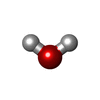
| #19: Water | ChemComp-HOH / |
|---|
-Details
| Has ligand of interest | N |
|---|
-Experimental details
-Experiment
| Experiment | Method: ELECTRON MICROSCOPY |
|---|---|
| EM experiment | Aggregation state: PARTICLE / 3D reconstruction method: single particle reconstruction |
- Sample preparation
Sample preparation
| Component |
| ||||||||||||||||||||||||||||||||||||
|---|---|---|---|---|---|---|---|---|---|---|---|---|---|---|---|---|---|---|---|---|---|---|---|---|---|---|---|---|---|---|---|---|---|---|---|---|---|
| Molecular weight | Value: 1.6 MDa / Experimental value: YES | ||||||||||||||||||||||||||||||||||||
| Source (natural) |
| ||||||||||||||||||||||||||||||||||||
| Source (recombinant) |
| ||||||||||||||||||||||||||||||||||||
| Buffer solution | pH: 8 | ||||||||||||||||||||||||||||||||||||
| Specimen | Conc.: 0.4 mg/ml / Embedding applied: NO / Shadowing applied: NO / Staining applied: NO / Vitrification applied: YES | ||||||||||||||||||||||||||||||||||||
| Vitrification | Instrument: FEI VITROBOT MARK IV / Cryogen name: ETHANE / Humidity: 95 % / Chamber temperature: 283 K |
- Electron microscopy imaging
Electron microscopy imaging
| Experimental equipment |  Model: Titan Krios / Image courtesy: FEI Company |
|---|---|
| Microscopy | Model: FEI TITAN KRIOS |
| Electron gun | Electron source:  FIELD EMISSION GUN / Accelerating voltage: 300 kV / Illumination mode: FLOOD BEAM FIELD EMISSION GUN / Accelerating voltage: 300 kV / Illumination mode: FLOOD BEAM |
| Electron lens | Mode: BRIGHT FIELD / Nominal magnification: 105000 X / Nominal defocus max: 3500 nm / Nominal defocus min: 1500 nm / Calibrated defocus min: 800 nm / Calibrated defocus max: 4500 nm / Cs: 0.01 mm / C2 aperture diameter: 70 µm / Alignment procedure: ZEMLIN TABLEAU |
| Specimen holder | Cryogen: NITROGEN / Specimen holder model: FEI TITAN KRIOS AUTOGRID HOLDER |
| Image recording | Average exposure time: 8 sec. / Electron dose: 52.8 e/Å2 / Detector mode: SUPER-RESOLUTION / Film or detector model: GATAN K2 QUANTUM (4k x 4k) |
| EM imaging optics | Energyfilter name: GIF Quantum LS / Energyfilter slit width: 20 eV |
- Processing
Processing
| EM software |
| ||||||||||||||||||||||||
|---|---|---|---|---|---|---|---|---|---|---|---|---|---|---|---|---|---|---|---|---|---|---|---|---|---|
| CTF correction | Type: PHASE FLIPPING AND AMPLITUDE CORRECTION | ||||||||||||||||||||||||
| Particle selection | Num. of particles selected: 1068534 | ||||||||||||||||||||||||
| Symmetry | Point symmetry: C1 (asymmetric) | ||||||||||||||||||||||||
| 3D reconstruction | Resolution: 20 Å / Resolution method: FSC 0.143 CUT-OFF / Num. of particles: 354104 / Symmetry type: POINT | ||||||||||||||||||||||||
| Atomic model building | Protocol: OTHER |
 Movie
Movie Controller
Controller








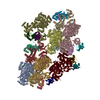
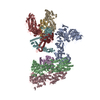
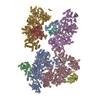



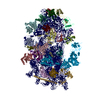

 PDBj
PDBj